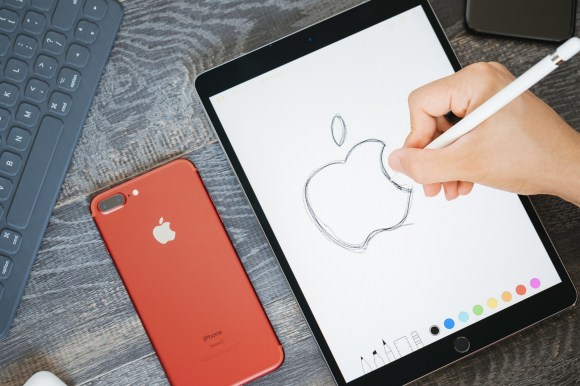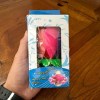
Not quite constructive criticism.
Drawing references are necessary tools for artists. We’ve seen everything from using chocolate as a reference for drawing rubble, to reference guides for what girls’ rooms look like (for people who have never been in one before).
References are necessary in order to convey realism through art. They help artists draw things that they’re unfamiliar with, so that they’re not just guessing at what something would look like, and the so that the final product doesn’t come out looking awkward or strange.
But here is an interesting question: at what point is something no longer a reference, but a “copy” instead? Japanese Twitter artist Harucha recently ran into this problem after posting this picture:
▼ “I found an incredibly beautiful ‘eagle’ photo, so I drew
Yuri [from Yuri!!!! on Ice] doing it. I’d like to see this for real!”
For those wondering, the “eagle” is an ice skating move where the skater moves with their toes pointed out and their heels pointed together. The model that Harucha used is American ice skater J.J. Cassar, presumably using this photo:
▼ It is a pretty impressive move!
小塚で思い出したけれど、あなた人間ですかと聞きたくなるカサー君の絶品イーグル。いまだかつてこれ以上のイーグルを見たことがない。 pic.twitter.com/epSFEjCBYc
— あくあまりん🐟ゼウスは天空を翔る (@openaquamarine) January 23, 2016
Harucha originally posted that picture back in July, and the world seemed to move on. But just the other day, the artist posted this conversation that occurred behind the scenes with one angry critic: (translation of conversation below)
▼ “This made me think about if using photos as a reference for pictures is bad.
But if I’m called out for ‘tracing’ when I’m just using it as a reference,
then I won’t be able to draw skating pictures anymore.”
Critic: “Hello Harucha-sama, my name is Nia. Sorry for the sudden message. I’m contacting you because your picture is trace-plagiarism.
Harucha: “Hello Nia. Thank you for contacting me with your concern! I received another message yesterday from someone else concerning that picture being trace-plagiarism, but I don’t see it at all. Like I said in my tweet, I only used it as a reference photo. It is a beautiful photo, and you should definitely check it out. Thank you very much.”
Critic: “But aren’t your pictures not supposed to be plagiarized? I can never forgive trace-plagiarism. I think you should provide proof.”
Harucha: “Just looking at it, the body proportions are different, so I don’t feel any need to provide proof. I appreciate your concern, but I don’t see the point in calling my picture a trace. Just doing a search for Cassar’s eagle should show you the original photo. Once you see for yourself, I think you’ll agree.”
Critic: “I saw it. So you’re basically admitting you trace-plagiarized the photo?
Critic: “I take your silence as a yes?”
Harucha: “I used it as a reference for the pose, but I did not trace it. Also, I’m working at the moment, so I cannot reply right away.”
Critic: “So it’s an ‘eye-trace’ then? You admit you traced it?”
Harucha: “I don’t know what ‘eye-tracing’ means, whether it’s ‘tracing’ or ‘copying’ or ‘referencing.’ I messaged you back with a throwaway account since you seemed genuinely concerned at first, but I will not be replying to you any further. Goodbye.”
Critic: You’re running away? Coward!!!! I am going to expose you.”
Oh man, I could feel my own anxiety levels rising just reading through that. It’s one thing to express a concern to someone, but it’s quite another to relentlessly attack them when you both have already clearly made your points.
Still, like Harucha said in their Twitter post, it does make you think: at what point does using a photo for reference go from “your own work” to “copying?” As a non-artist myself, I don’t feel qualified to give an answer, but Japanese Twitter chimed in with their own replies:
“I think this person is taking the definition of ‘trace’ way too far.”
“Do they also think you can’t use photos of bodybuilders or models to draw muscular characters?”
“The critic was just looking to argue. I mean, what the hell is ‘eye-tracing?'”
“They critic must not draw very much. There are people out there who think that computers just draw digital art themselves, so I guess there are those who think tracing and copying are ‘plagiarism’ too. I wish they’d understand that to get better at anything you have to use references.”
“The more professional you are, the more references you accumulate. I was told, ‘You only know what’s in your brain. To add new things to it, you must look at them.’ So yeah, don’t worry and keep drawing wonderful pictures. (Also, LOL ‘eye-tracing.’)”
It seems like the vast majority side with Harucha, and I have to agree. If I ever needed to draw schoolgirls pointing a gun, I’d use a reference for that; if I ever needed to draw two boys in love frolicking by a pool, I’d use a reference for that.
So long as the artist puts their own twist on the piece with backgrounds, colors, shape, tone, or any number of other ways, I don’t think it’s far to call it a copy… or an “eye-trace,” whatever that is.
Source: Twitter/@yk_hal00 via Hachima Kiko
Top image: Pakutaso

 Potential prime minister successor posts seemingly heartwarming photo, it backfires immediately
Potential prime minister successor posts seemingly heartwarming photo, it backfires immediately Manga materials website offers thousands of reference poses for budding artists to download
Manga materials website offers thousands of reference poses for budding artists to download Japanese Twitter spills secret on how to draw perfect feet: Use an 8, some 6s, and an 11
Japanese Twitter spills secret on how to draw perfect feet: Use an 8, some 6s, and an 11 We interview voice actress Shoko Nakagawa, learn what gave her the greatest shock of her career
We interview voice actress Shoko Nakagawa, learn what gave her the greatest shock of her career Japanese Twitter artist gives hilarious suggestion for when you can’t draw a character’s body
Japanese Twitter artist gives hilarious suggestion for when you can’t draw a character’s body Foreigner’s request for help in Tokyo makes us sad for the state of society
Foreigner’s request for help in Tokyo makes us sad for the state of society Japanese city loses residents’ personal data, which was on paper being transported on a windy day
Japanese city loses residents’ personal data, which was on paper being transported on a windy day Harajuku Station’s beautiful old wooden building is set to return, with a new complex around it
Harajuku Station’s beautiful old wooden building is set to return, with a new complex around it Ghibli Park now selling “Grilled Frogs” from food cart in Valley of Witches
Ghibli Park now selling “Grilled Frogs” from food cart in Valley of Witches Starbucks Japan releases new mugs and gifts for Mother’s Day
Starbucks Japan releases new mugs and gifts for Mother’s Day Historical figures get manga makeovers from artists of Spy x Family, My Hero Academia and more
Historical figures get manga makeovers from artists of Spy x Family, My Hero Academia and more Stunning high-definition promotional short of Hokkaido city leaves jaws hanging【Video】
Stunning high-definition promotional short of Hokkaido city leaves jaws hanging【Video】 Japan’s massive matcha parfait weighs 6 kilos, contains hidden surprises for anyone who eats it
Japan’s massive matcha parfait weighs 6 kilos, contains hidden surprises for anyone who eats it Red light district sushi restaurant in Tokyo shows us just how wrong we were about it
Red light district sushi restaurant in Tokyo shows us just how wrong we were about it Celebrate another year of life by putting it in jeopardy with this birthday candle flower
Celebrate another year of life by putting it in jeopardy with this birthday candle flower McDonald’s new Happy Meals offer up cute and practical Sanrio lifestyle goods
McDonald’s new Happy Meals offer up cute and practical Sanrio lifestyle goods Japanese ramen restaurants under pressure from new yen banknotes
Japanese ramen restaurants under pressure from new yen banknotes All-you-can-drink Starbucks and amazing views part of Tokyo’s new 170 meter-high sky lounge
All-you-can-drink Starbucks and amazing views part of Tokyo’s new 170 meter-high sky lounge French Fries Bread in Tokyo’s Shibuya becomes a hit on social media
French Fries Bread in Tokyo’s Shibuya becomes a hit on social media Studio Ghibli releases new action figures featuring Nausicaä of the Valley of the Wind characters
Studio Ghibli releases new action figures featuring Nausicaä of the Valley of the Wind characters New private rooms on Tokaido Shinkansen change the way we travel from Tokyo to Kyoto
New private rooms on Tokaido Shinkansen change the way we travel from Tokyo to Kyoto Studio Ghibli glasses cases let anime characters keep an eye on your spectacles
Studio Ghibli glasses cases let anime characters keep an eye on your spectacles Tokyo Tsukiji fish market site to be redeveloped with 50,000-seat stadium, hotel, shopping center
Tokyo Tsukiji fish market site to be redeveloped with 50,000-seat stadium, hotel, shopping center Beautiful Ghibli sealing wax kits let you create accessories and elegant letter decorations【Pics】
Beautiful Ghibli sealing wax kits let you create accessories and elegant letter decorations【Pics】 Studio Ghibli releases Kiki’s Delivery Service chocolate cake pouches in Japan
Studio Ghibli releases Kiki’s Delivery Service chocolate cake pouches in Japan New definition of “Japanese whiskey” goes into effect to prevent fakes from fooling overseas buyers
New definition of “Japanese whiskey” goes into effect to prevent fakes from fooling overseas buyers Our Japanese reporter visits Costco in the U.S., finds super American and very Japanese things
Our Japanese reporter visits Costco in the U.S., finds super American and very Japanese things Studio Ghibli unveils Mother’s Day gift set that captures the love in My Neighbour Totoro
Studio Ghibli unveils Mother’s Day gift set that captures the love in My Neighbour Totoro New Japanese KitKat flavour stars Sanrio characters, including Hello Kitty
New Japanese KitKat flavour stars Sanrio characters, including Hello Kitty More foreign tourists than ever before in history visited Japan last month
More foreign tourists than ever before in history visited Japan last month New Pokémon cakes let you eat your way through Pikachu and all the Eevee evolutions
New Pokémon cakes let you eat your way through Pikachu and all the Eevee evolutions Sales of Japan’s most convenient train ticket/shopping payment cards suspended indefinitely
Sales of Japan’s most convenient train ticket/shopping payment cards suspended indefinitely Sold-out Studio Ghibli desktop humidifiers are back so Totoro can help you through the dry season
Sold-out Studio Ghibli desktop humidifiers are back so Totoro can help you through the dry season Japanese government to make first change to romanization spelling rules since the 1950s
Japanese government to make first change to romanization spelling rules since the 1950s Ghibli founders Toshio Suzuki and Hayao Miyazaki contribute to Japanese whisky Totoro label design
Ghibli founders Toshio Suzuki and Hayao Miyazaki contribute to Japanese whisky Totoro label design Doraemon found buried at sea as scene from 1993 anime becomes real life【Photos】
Doraemon found buried at sea as scene from 1993 anime becomes real life【Photos】 Tokyo’s most famous Starbucks is closed
Tokyo’s most famous Starbucks is closed One Piece characters’ nationalities revealed, but fans have mixed opinions
One Piece characters’ nationalities revealed, but fans have mixed opinions We asked a Uniqlo employee what four things we should buy and their suggestions didn’t disappoint
We asked a Uniqlo employee what four things we should buy and their suggestions didn’t disappoint Princesses, fruits, and blacksmiths: Study reveals the 30 most unusual family names in Japan
Princesses, fruits, and blacksmiths: Study reveals the 30 most unusual family names in Japan Japanese rocker shares granny’s art online, Twitter goes wild, she sends note of thanks in return
Japanese rocker shares granny’s art online, Twitter goes wild, she sends note of thanks in return Gackt to guys not interested in cars: “Are you queer?”
Gackt to guys not interested in cars: “Are you queer?” Japanese wasp-filled crackers: Their sting is far worse than a bite
Japanese wasp-filled crackers: Their sting is far worse than a bite Man doesn’t want to waste money on software, creates brilliant illustrations on Excel instead
Man doesn’t want to waste money on software, creates brilliant illustrations on Excel instead Japanese netizens shocked by the sight of sumo wrestlers bathing in hot spring
Japanese netizens shocked by the sight of sumo wrestlers bathing in hot spring Awesome carved eraser stamps are something to marvel, but leave some skeptical
Awesome carved eraser stamps are something to marvel, but leave some skeptical You’ll be surprised when you see who draws these adorable moe characters
You’ll be surprised when you see who draws these adorable moe characters Japanese Twitter user transforms his home into the inside of a video game using glow tape
Japanese Twitter user transforms his home into the inside of a video game using glow tape Gotta draw ‘em all! New 3DS game teaches players how to draw over 100 different Pokémon
Gotta draw ‘em all! New 3DS game teaches players how to draw over 100 different Pokémon Hand-made…hands?! Japanese girl has the perfect, horrible solution to going to the movies alone
Hand-made…hands?! Japanese girl has the perfect, horrible solution to going to the movies alone Perfume fans insult Perfume by being angry at celebrity who didn’t really insult Perfume
Perfume fans insult Perfume by being angry at celebrity who didn’t really insult Perfume Japanese government recommends changing Buddhist temple mark on maps to avoid Nazi connotations
Japanese government recommends changing Buddhist temple mark on maps to avoid Nazi connotations Japanese police to introduce video function to emergency 110 calls
Japanese police to introduce video function to emergency 110 calls Here’s why you should be careful when buying a coffee cup from Japan’s 100 yen stores
Here’s why you should be careful when buying a coffee cup from Japan’s 100 yen stores
Leave a Reply